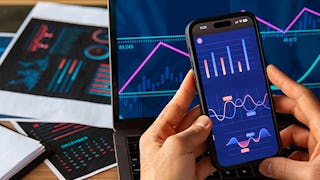Welcome to the Macroeconomics course! This course is designed to provide you with a deep understanding of what an economy is, how it operates, and the factors that sustain and influence economic activity, including the role of policy interventions. You will explore macroeconomic policy analysis at the national level, essentially focusing on short-term macroeconomics, generally described as macroeconomic stabilization against growth or long-term macroeconomics. You will comprehend the theoretical frameworks through a contextualized treatment of concepts considering the experiences in the developing world and the global economy. You will get familiarized with the major macroeconomic debates. The course emphasizes intuitive learning of concepts with the help of diagrams, with only limited reliance on statistical or mathematical techniques.



Expérience recommandée
Ce que vous apprendrez
Examine macroeconomic variables, estimation, and their interpretation in a real-world context.
Evaluate the conceptual macroeconomic frameworks and analytical tools to understand the working of an open economy.
Elaborate the working of fiscal and monetary policy and the institutional context in a developing economy.
Compétences que vous acquerrez
- Catégorie : Tax
- Catégorie : Market Dynamics
- Catégorie : Supply And Demand
- Catégorie : Fiscal Management
- Catégorie : Growth Strategies
- Catégorie : International Finance
- Catégorie : Key Performance Indicators (KPIs)
- Catégorie : Estimation
- Catégorie : Economics
- Catégorie : Policy Analysis
- Catégorie : Financial Policy
- Catégorie : Policy Development
- Catégorie : Economic Development
- Catégorie : Accounting
- Catégorie : Business Economics
- Catégorie : Social Sciences
Détails à connaître

Ajouter à votre profil LinkedIn
22 devoirs
Découvrez comment les employés des entreprises prestigieuses maîtrisent des compétences recherchées


Obtenez un certificat professionnel
Ajoutez cette qualification à votre profil LinkedIn ou à votre CV
Partagez-le sur les réseaux sociaux et dans votre évaluation de performance

Il y a 7 modules dans ce cours
This module introduces you to the basic macroeconomics concepts, macroeconomic indicators, and related terminologies. It defines an economy, its actors, and the notion of output gap. You will look at the circular flow of income, which highlights the importance of the system’s economic stability in sustaining economic activity and growth.
Inclus
7 vidéos2 lectures3 devoirs
This module discusses the measurement of macroeconomic indicators and related issues. It is essential to track economic activity and provide evidence-based policy prescriptions when there are concerns about the stability and sustainability of the economy with consequences for the behavior of various economic agents. It elaborates conventions that guide the system of national income accounting. You will also discuss the use of GDP as an indicator of economic activity, its limitations, and its use in tracking human and social well-being.
Inclus
8 vidéos1 lecture4 devoirs
This module discusses the conceptual or the theoretical underpinnings of aggregate supply and demand schedules. It elaborates on the Classical and Keynesian premises of macroeconomic analysis. This is followed up with an elaboration of empirical evidence for the aggregate supply schedule by visiting the Phillips curve and its modern interpretation involving the relationship between inflation and unemployment.
Inclus
7 vidéos1 lecture4 devoirs
The aggregate demand, the Keynesian contribution to macroeconomic analysis, is the main driver in the short-term stabilization of the economy. This module discusses the components of aggregate demand – consumption, investment, government spending, and net exports. By analyzing the demand for money and how the money market works, you will gain insights into developing an integrated treatment of the goods and the money market.
Inclus
7 vidéos1 lecture2 devoirs
This module advances you to macroeconomic analysis by integrating the functioning of the money and the goods markets with the help of the IS-LM analytical tool kit. It goes on to elaborate the use of fiscal and monetary policy, identifying the application of specific policy instruments, for macroeconomic stabilization of an economy. It also discusses the institutional context of conducting fiscal and monetary policy.
Inclus
7 vidéos1 lecture4 devoirs
This module takes the final step in bringing macroeconomic analysis to the real-world context. It includes the external sector, thereby opening up the scope for capital flows, apart from trade in merchandise and services in the economy. You will look at the functioning of foreign exchange markets against the backdrop of flexible exchange rate regimes and some others. It goes on to highlight the efficacy of fiscal and monetary policy in the context of an open economy.
Inclus
7 vidéos2 lectures3 devoirs
This module highlights some important macroeconomic debates and their influence on the development thinking of the times. It traces how the role of the state and markets evolved in that context. It discusses the success stories of the 20th century and the countries that transited from the developing status to the developed ones. You will explore how that transition may have been helped using unorthodox or heterodox macroeconomic policy instead of the orthodox prescription pursued in this course. The module also describes the contours of a heterodox macroeconomic policy approach.
Inclus
7 vidéos2 lectures2 devoirs
Instructeur

Offert par
Pour quelles raisons les étudiants sur Coursera nous choisissent-ils pour leur carrière ?





Accédez à tous ces cours et à bien d'autres encore grâce à un abonnement


Rice University


Fundação Instituto de Administração


Rice University


O.P. Jindal Global University

Débloquer l'accès aux cours 10,000+ avec un abonnement
Explorez les rôles et les compétences, apprenez plus efficacement avec Coursera Coach et obtenez des diplômes reconnus.
Faites progresser votre carrière avec un diplôme en ligne
Obtenez un diplôme auprès d’universités de renommée mondiale - 100 % en ligne
Rejoignez plus de 3 400 entreprises mondiales qui ont choisi Coursera pour les affaires
Améliorez les compétences de vos employés pour exceller dans l’économie numérique
Foire Aux Questions
Access to lectures and assignments depends on your type of enrollment. If you take a course in audit mode, you will be able to see most course materials for free. To access graded assignments and to earn a Certificate, you will need to purchase the Certificate experience, during or after your audit. If you don't see the audit option:
The course may not offer an audit option. You can try a Free Trial instead, or apply for Financial Aid.
The course may offer 'Full Course, No Certificate' instead. This option lets you see all course materials, submit required assessments, and get a final grade. This also means that you will not be able to purchase a Certificate experience.
When you purchase a Certificate you get access to all course materials, including graded assignments. Upon completing the course, your electronic Certificate will be added to your Accomplishments page - from there, you can print your Certificate or add it to your LinkedIn profile. If you only want to read and view the course content, you can audit the course for free.
You will be eligible for a full refund until two weeks after your payment date, or (for courses that have just launched) until two weeks after the first session of the course begins, whichever is later. You cannot receive a refund once you’ve earned a Course Certificate, even if you complete the course within the two-week refund period. See our full refund policy.
Plus de questions
Aide financière disponible,


